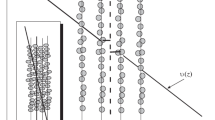Abstract
The point of view is substantiated, according to which the term “fluid viscosity” refers to the physical parameter characterizing the energy costs for overcoming the internal (molecular) friction forces during translational and rotational motion of solids in liquids and spatial movement (flow) of liquids themselves. It is shown that in the framework of this approach, the viscosity has a dimension J s m–3, and its numerical value depends on three parameters: the heat of evaporation of the liquid at the melting temperature, the average duration of intermolecular contacts at a given temperature and the characteristic for each liquid critical value of this parameter.





Similar content being viewed by others
Notes
The reduction of Rcr in the addend is incorrect, since in the physical sense, the actual independent variable is precisely the product F Rcr. The numerical value F itself is correct to calculate from the equality
$$F = {{4{\pi ^2}H{R_{{\rm{cr}}}}} \over t}\left( {{W_L} - {{\pi R_0^2{\rho _{\rm{L}}}} \over t}} \right),$$in which Rcr is the inner radius of the outer cylinder.
REFERENCES
Kratkaya khimicheskaya entsiklopediya (Brief Chemical Encyclopedia), Moscow: Sovetskaya Entsiklopediya, 1961, vol. 1, p. 717.
Fizicheskii entsiklopedicheskii slovar’ (Physical Encyclopedic Victionary), Moscow: Sovetskaya Entsiklopediya, 1983, pp. 99, 725.
Reid, R.C., Prausnitz, J.M., and Sherwood, Th.K., The Properties of Gases and Liquids, Mc. Graw-Hill Inc. 1977.
Newton, I., Matematicheskie nachala natural’noi filosofii (Mathematical Principles of Natural Philosophy), Moscow: Lenand, 2017, pp. 486–488.
Alenitsyn, A.G., Butikov, E.I., and Kondrat’ev, A.S., Kratkii fiziko-matematicheskii spravochnik (Brief Physics and Mathematics Reference), Moscow: Nauka, 1990, p. 190.
Stokes, G., Mathematical and Physical Papers, Cambridge: University Press, 1880, vol. 1, p. 103.
Barr, G., A Monograph of Viscometry, London: Hymphrey Milford, 1931.
Widemann, G., Pogg. Ann., 1856, vol. 99, p. 221.
Hagenbach, Ed., Pogg. Ann., 1860, vol. 109, p. 385.
Entsiklopediya polimerov (Encyclopedia of Polymers), Moscow: Sovetskaya Entsiklopediya, 1972, vol. 1, pp. 470–484.
Moelwyn-Hughes, E.A., Physical Chemistry, Second Revised Edition, London: Pergamon Press, 1961.
Kireev, V.A., Kurs fizicheskoi khimii (Physical Chemistry Course), Moscow: Khimiya, 1975, p. 223.
Hildebrand, J.H., Solubility of Nonelectrolytes, New York: Reinhold Publishing Corp., 1936.
Vargaftik, N.V., Spravochnik po teplofizicheskim svoistvam gazov i zhidkostei (Handbook on Thermophysical Properties of Gases and Liquids), Moscow: Nauka, 1972.
Author information
Authors and Affiliations
Corresponding authors
Ethics declarations
No conflict of interest was declared by the authors.
Additional information
Translated from Rossiiskii Khimicheskii Zhurnal, 2020, Vol. 64, No. 1, pp. 3–12. https://doi.org/10.6060/rcj.2020641.1.
Rights and permissions
About this article
Cite this article
Mizerovskiy, L.N., Smirnov, P.R. Viscosity and Internal Friction in Liquids. Russ J Gen Chem 91, 1797–1806 (2021). https://doi.org/10.1134/S1070363221090279
Received:
Revised:
Accepted:
Published:
Issue Date:
DOI: https://doi.org/10.1134/S1070363221090279




